It’s a Wednesday afternoon in the Unit Operations Lab on the Mines campus, and Nick Martella, a senior in chemical and biological engineering, just tapped the keg. He fills a clear plastic cup with a light amber ale he and two classmates spent weeks brewing themselves. Just as he sets it on the table and goes to fill another, the interim department head Colin Wolden appears. But instead of eying Martella with a disapproving look, Wolden reaches for a cup, takes a sip, and jots down a few notes.
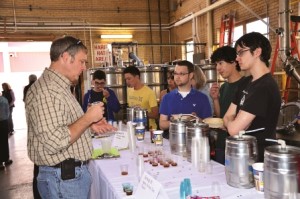
Students from the �Introduction to Brewing Science� class at Mines await the verdict as Pete Turner �90, MS �94 tastes the team�s crafted beer. Turner is a manufacturing systems engineer and sensory panelist at MillerCoors.
�It’s finals week, and for Martella and the 39 other students nervously pouring beer around the room for local brewers and Mines faculty, today’s taste test is worth 20 percent of their grade. We are drinking their final, says Wolden. This spring’s inaugural Introduction to Brewing Science course marks the latest chapter in a long, synergistic relationship between Mines and beer. It also signals the start of what for some in the class could be a bright future in the burgeoning craft brewing industry.
Colorado ranks second in the nation for production and economic impact of craft breweries, with more than 232 breweries state-wide (double the number in 2009) generating $826 million in 2013, according to the Colorado Brewers Guild. While many people associate Mines grads with the oil and gas and mining industries, dozens of alumni have taken a different course over the years, applying their rich knowledge of microbiological processes, mechanical design, and quality-control to engineering a better beer. With its first-ever official brewing science course so popular that it had to turn away about 40 students, the school is now mulling how to expand such offerings in the future and is even considering adding a brewing minor.
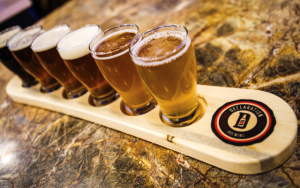
Photo courtesy of Declaration Brewing
Brewing is a classic chemical engineering process, says Wolden, noting that students learn about fermentation, distillation, enzyme kinetics, heat transfer and thermodynamics, and a host of other processes that can be applied across a broad range of industries.
Both Mines and Colorado have long been very beer-centric, says Dave Thomas, retired head brewer for Coors Brewing Company and author of the book Of Mines and Beer: 150 Years of Brewing History. The first Colorado brewery, Rocky Mountain Brewing Company, opened on the Front Range in 1859 to serve the many thirsty miners that had come to the foothills in search of work. In 1873, German-born brewer Adolph Coors converted an old tannery east of Golden into a brewery. That same year, Colorado School of Mines opened its doors.
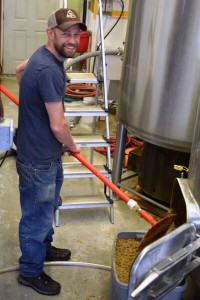
Josh Robbins �95, PhD �03 rakes out the grain from the mash tun at Mountain Toad Brewing. (Kaylee Robbins)
It made sense for Mines and Coors to work together, says Thomas. At one point, Coors paid for an underground pipeline to pump brewery steam to Mines buildings for heat. To this day, on a snowy morning, you can see a clear line of melted snow delineating the warm pipe. For decades, it has been a Friday afternoon ritual for Mines students to migrate down the hill for the short tour at Coors lab heading straight to the tasting room. Coors brewers frequently lecture at Mines classes, and Thomas guesses at least 50 alumni have worked at Coors Brewery over the years. A Mines education sets them up nicely for a large industrial plant like Coors.
Their education also set them up nicely for the craft brewing industry, which emerged in Colorado in the late 1970s. In 1978, the national Brewers Association was founded in Boulder. In 1982 the first Great American Beer Festival was held in Colorado (the event now hosts 50,000). While some large brewers vowed to crush the fledgling craft, Coors took a rising-tide-floats-all-boats approach, loaning barley, hops, and expertise to upstarts many of them from Mines working to evolve beer as we know it. Back when I first started at Coors in 1975, everybody in the industry was applying science to try to essentially make the same beer: a pale, bright, crisp lager, recalls Thomas. Today, brewers are applying science to brew beers that have never been brewed before with ingredients that have never been used before.
While many view brewing as an art, chemical engineering alumnus Mike Blandford ’11 sees the process as more of a science. We are using biological materials to turn sugar into alcohol, he says. After 18 months in the oil and gas industry, Blandford teamed up with Mines associate professor Paul Ogg and Mines alumnus Greg Schlichting ’09 to found Declaration Brewing in November 2014. With a 2,000-square-foot tap room, a beer garden double that size, 18 beers, and taps for 32 more, the Denver brewery has already garnered a loyal following. But Blandford is most proud of what goes on in the lab. Unlike many breweries, which use one or two yeast strains bought off-site to convert sugars from grain into alcohol, Declaration propagates its own yeast. By growing its own, Blandford says, the brewery can boost production and save money, create a wider palette of flavors, and have more control over purity.
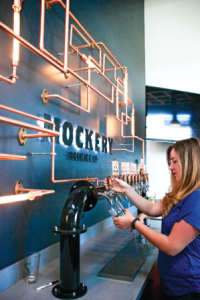
Sara Heinle �13 pours Mockery Brewing�s Salted Scotch Ale. (Mockery Brewing)
Declaration’s founders also use their biochemical wizardry to develop new flavors. For instance, when a specific yeast interacts with the alpha acid byproduct of a specific kind of hops, it forms a strawberry-flavored molecule. We can make a strawberry beer without ever touching a strawberry, Blandford says. Meanwhile, state-of-the-art analytical testing equipment enables them to look at things like alcohol content, color, turbidity, and bitterness at various stages in the brewing process, and manipulate them to assure that each batch of beer is consistent even when the ingredients vary from season to season. There is a big campaign in the craft brewing industry for everyone to up their quality control game, Blandford says.
Coming from an engineering background can also help a newcomer entering the brewing industry save money and time, alumni say. Josh Robbins earned his first degree in chemical engineering from Mines in 1995 and went to work for Texas Instruments developing semi-conductors. He finished his PhD in 2003 and then founded two companies that developed novel thin-film technologies. After visiting 108 of Colorado’s breweries with his wife Kaylee Robbins MS ’09, PhD ’13, the long-time home brewers opted for a drastic career change. In 2013, they opened Mountain Toad Brewing in a former machine shop just blocks from where Coors developed the first aluminum beer can in 1959. Josh drew on his mechanical skills to save roughly $100,000 by installing his own pumps and control boxes, and Kaylee developed the business plan. Today, for the first time in his entrepreneurial career, Robbins is enjoying positive cash flow. And the conferences I get to go to now are a little more fun, he jokes.
Mines alumnae and siblings Rachel Rabun ’08 and Sara Heinle ’13 work at petroleum engineering jobs by day, but at night they put their skills to work on the business side of things at Mockery Brewing, a new craft brewery they co-own in Denver’s River North District. Just today, we were trying to determine whether we wanted to change our hours, says Rabun. So, in true Mines fashion, I downloaded all of our sales data by hour and wrote a code to organize it. When something breaks, she adds, We know how to fix stuff, because we went to Mines.
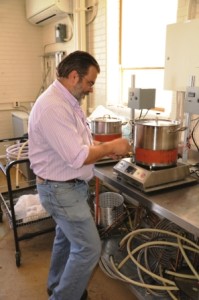
Laboratory coordinator Mike Stadick tests brewing equipment in the Chemical and Biological Engineering Department at Mines. (Laurie Schmidt)
Mines alumni working as craft brewers say they get together often to share advice, and many are now paying it forward, serving as guest lecturers for the new Intro to Brewing Class and volunteering as taste testers for the recent course final. With the help of lab coordinator Mike Stadick, students were assigned to brew two 1-gallon kegs, using specialized equipment to malt their own barley (germinating and roasting it), mash and boil it to convert its starches into sugars, add hops for flavor, and add yeast to convert those sugars to alcohol. Decisions they made along the way influenced the color, aroma, flavor, mouth feel and alcohol content, which they then assessed using various analytical tools.
Not everything went smoothly, however. We had to throw our first batch of barley out because it turned to sludge, says Martella. And our first batch of beer had to go, too we put too much yeast in and it tasted like dough.
In the end, his team of three served up a tasty, mildly bitter American Pale Ale with five percent alcohol that seemed to please the judges. Martella also walked away with a new career choice in mind. I can definitely see myself opening a brewery someday.

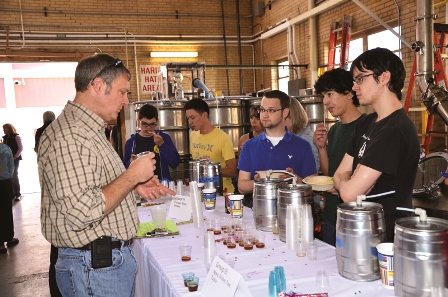


Nice article, you failed to mention of CSM’s first Brew Master, Chuck Hahn. Chuck earned 3 degrees from CSM including a doctorate in Chemical and Petroleum Engineering. I think he graduated in 1970 and joined Coors in 1971.
I met Chuck while I was a student at Mines and while he was in charge of the pilot brewery at Coors. I still remember him giving me a private tour of the 2-story facility where he �experimented� with how to make beer better.
But my best memory is when he brought one of his test batches to the Kappa Sigma house in the spring of 1974 or 1975. He wanted to get our reaction to a new brew. He insisted we drink it from the dark brown bottles before allowing us to pour the beer into glasses. When we did we were shocked that the color, instead of the usual pale yellow was actually amber red! To this day I am convinced that we had just sampled an early version of Killian’s Irish Red.
Chuck moved to Australia in the early 1980s, made quite a name for himself in the beer industry down-under, and founded the very successful Hahn Brewing Company.
Dale Fenwick
Mining 1976
PS Here are some links of interest: